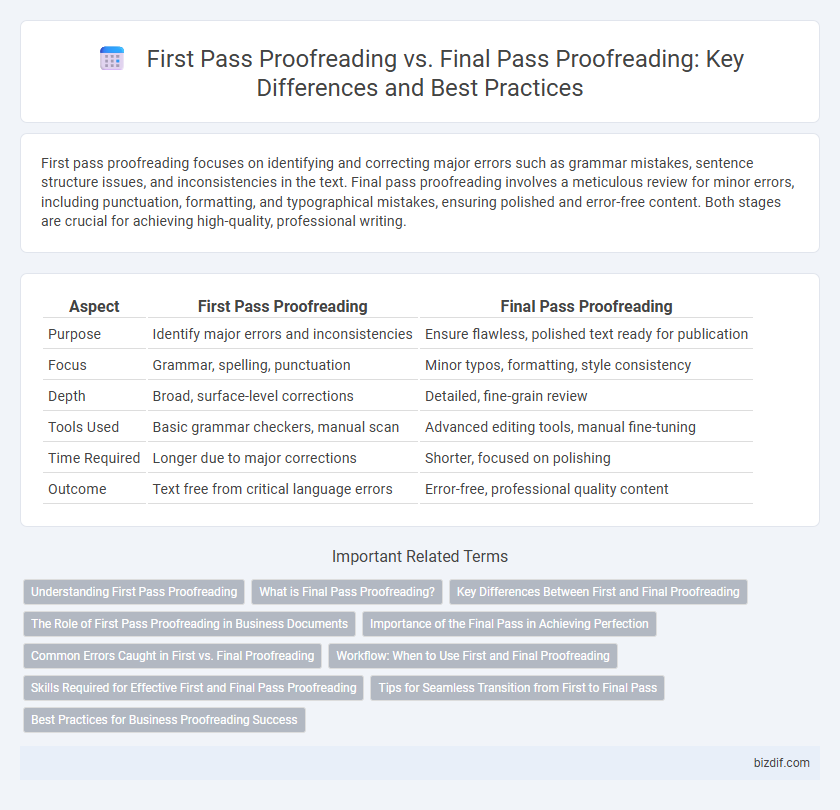First pass proofreading focuses on identifying and correcting major errors such as grammar mistakes, sentence structure issues, and inconsistencies in the text. Final pass proofreading involves a meticulous review for minor errors, including punctuation, formatting, and typographical mistakes, ensuring polished and error-free content. Both stages are crucial for achieving high-quality, professional writing.
Table of Comparison
| Aspect | First Pass Proofreading | Final Pass Proofreading |
|---|---|---|
| Purpose | Identify major errors and inconsistencies | Ensure flawless, polished text ready for publication |
| Focus | Grammar, spelling, punctuation | Minor typos, formatting, style consistency |
| Depth | Broad, surface-level corrections | Detailed, fine-grain review |
| Tools Used | Basic grammar checkers, manual scan | Advanced editing tools, manual fine-tuning |
| Time Required | Longer due to major corrections | Shorter, focused on polishing |
| Outcome | Text free from critical language errors | Error-free, professional quality content |
Understanding First Pass Proofreading
First pass proofreading involves an initial review focused on identifying glaring spelling, grammar, and punctuation errors to improve overall readability. It sets the foundation for the final pass by catching obvious mistakes and ensuring basic accuracy, allowing subsequent proofreading stages to concentrate on finer details. This step is crucial for maintaining the integrity of a document's content and streamlining the editing process.
What is Final Pass Proofreading?
Final pass proofreading is the last stage of the proofreading process, focusing on detecting and correcting any remaining errors in grammar, punctuation, spelling, and formatting before publication or submission. This step ensures text accuracy, consistency, and adherence to style guides, improving overall readability and professionalism. It differs from first pass proofreading by concentrating on fine-tuning details rather than identifying broad or structural mistakes.
Key Differences Between First and Final Proofreading
First pass proofreading centers on identifying and correcting major errors such as spelling mistakes, grammatical issues, and formatting inconsistencies, providing a broad overview of the document's quality. Final pass proofreading delves deeper into fine-tuning punctuation, typography, and contextual nuances to ensure overall coherence and polish. Key differences include the scope of error detection, with the first pass focusing on structural corrections and the final pass emphasizing detail accuracy and stylistic refinement.
The Role of First Pass Proofreading in Business Documents
First pass proofreading in business documents primarily aims to identify and correct glaring errors in grammar, spelling, and formatting, ensuring the text is polished enough for initial review. This stage significantly reduces the volume of mistakes, allowing subsequent proofreading passes to focus on finer details such as tone, consistency, and factual accuracy. By efficiently catching major issues early, first pass proofreading enhances overall document quality and accelerates the approval process in corporate communication.
Importance of the Final Pass in Achieving Perfection
The final pass proofreading is crucial for attaining perfection as it involves a meticulous review of content to catch overlooked errors, ensuring clarity and consistency throughout the text. This stage focuses on fine-tuning grammar, punctuation, and formatting, which directly impacts the professionalism and readability of the document. By addressing subtle mistakes and refining language nuances, the final pass elevates the overall quality beyond the initial first pass proofreading.
Common Errors Caught in First vs. Final Proofreading
First pass proofreading typically identifies obvious errors such as typographical mistakes, formatting inconsistencies, and glaring grammatical issues. Final pass proofreading focuses on subtle errors including sentence flow, punctuation precision, and overall coherence, ensuring the text is polished and publication-ready. Common errors caught during first pass include misspellings and misplaced capitals, while final pass targets nuances like homophone misuse and context-specific style adherence.
Workflow: When to Use First and Final Proofreading
First pass proofreading is primarily used during the initial stages of the editing process to identify and correct major errors in grammar, structure, and content accuracy. Final pass proofreading occurs after all revisions are complete, focusing on catching minor typos, formatting inconsistencies, and punctuation errors to ensure a polished, publication-ready document. Using the first pass early in the workflow streamlines content refinement, while the final pass guarantees error-free presentation before distribution.
Skills Required for Effective First and Final Pass Proofreading
First pass proofreading requires strong skills in identifying major content errors, structural issues, and inconsistencies in tone or style, demanding a broad focus on overall document coherence. Final pass proofreading emphasizes meticulous attention to detail, including grammar, punctuation, spelling, and formatting accuracy, ensuring the text is polished and error-free. Effective proofreading combines critical reading skills, excellent language proficiency, and a keen eye for subtle discrepancies tailored to each stage's objectives.
Tips for Seamless Transition from First to Final Pass
Implement a structured checklist to track changes from the first pass proofreading stage, ensuring all initial errors are addressed before moving to the final pass. Prioritize clear communication between editors and proofreaders to clarify ambiguous corrections and maintain consistency. Utilize version control tools to compare drafts efficiently, facilitating a smooth and accurate transition from the first to the final pass proofreading.
Best Practices for Business Proofreading Success
First pass proofreading focuses on identifying and correcting major errors such as grammar, spelling, and punctuation to ensure clarity and professionalism in business documents. Final pass proofreading serves to catch overlooked mistakes, verify formatting consistency, and confirm adherence to company style guides, enhancing overall document accuracy. Employing a systematic two-step proofreading approach improves communication effectiveness and reduces costly errors in corporate communications.
First pass proofreading vs Final pass proofreading Infographic

 bizdif.com
bizdif.com